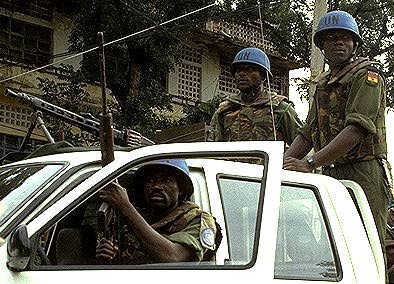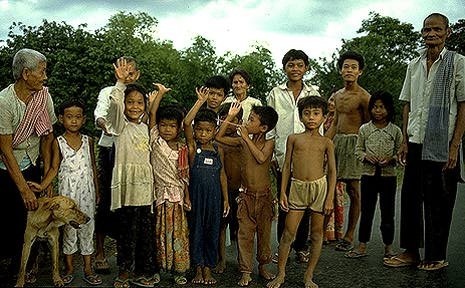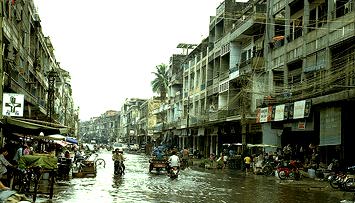The Remaining Right Side of the Buddha
Part 2: Udong Danger
Wednesday - May 19, 1993
Wednesday was the last day for campaigning. There would then be a three day "cooling-off" period before elections were to begin. Polling was to be conducted over a six day period. Jack and I rented a 70cc Honda motorbike and rode across town towards the National Museum. Compared to the chaos and congestion of the streets of Saigon that I had just recently left, Phnom Penh's wide boulevards were calm and orderly. Instead of bicycles, flashy white cars and trucks dominated the traffic - the letters "UN" emblazoned in black on either side boldly identified how such expensive vehicles came to be in such a poor country. Our destination was the campaign period's final rally being held in a large open space in front of the National Museum near the banks of the Tonlé Sap River just shy of where it merges into the Mekong.
We ditched the motorbike under a large, sweeping tree and ambled over to where the Ghanian band was belting out an upbeat tune. A modest stage had been erected and it was overflowing with candidates and photographers jostling for position. The stage looked out on a large crowd which had arranged itself so as to avoid large puddles of mud in the open plaza. The mood was serious; only a tad festive. Many in the crowd wore the light blue t-shirts that had been given out to election volunteers. In contrast to the bright t-shirts, near the front sat rows of shaven-headed Buddhist nuns in plain white robes.
Candidates from 19 of the 20 parties took their turns at the stage microphone. As they addressed the crowd, heavily armed UNTAC soldiers from Ghana patrolled the area in ATV's.  The band had proven to be a friendly bunch but their counterpoints on patrol were
brutally serious - posing for photographs, they refused even the slightest hint of a smile. The band had proven to be a friendly bunch but their counterpoints on patrol were
brutally serious - posing for photographs, they refused even the slightest hint of a smile.
On the fringes, a few of the political parties had set up tables. One group displayed a large banner reading "Communism is Evil" attributing the quote to Ron Reagan. This group's proposal for a new Cambodian flag was the familiar stars-and-stripes of the U.S. with the stars replaced by a rendering of Cambodia's most famous landmark, Angkor Wat.
As a by-product of Prince Sihanouk pulling out of the election, UNTAC had disallowed the use of his picture by any of the competing parties. Nonetheless, a photo of Prince Ranariddh kneeling in respect at his father's feet was a common sight on posters and t-shirts.
Ranariddh, speaking for his royalist party (known by its French acronym, Funcinpec), got the biggest reaction from the crowd and the sense that Funcinpec would win the election was reinforced.
Shortly after Ranariddh's speech, Jack and I decided to hit the road for Udong.
We looked for the large tree under which we had left the bike. Finding the tree, we realized we had parked amongst a large collection of Honda 70 motorbikes that all looked remarkably alike. Neither of us had bothered to note the license plate number or
any distinguishing characteristics of the bike. The musicians from Ghana had a good laugh at our expense as we scratched our heads and went from bike to bike trying the key.
After a bite to eat, Jack and I rode the 40km northwest to Udong. Udong served as the capital of Cambodia between 1618 and 1866. A bit south of the old capital are a series of hills known as Phnom Udong. The hills and surrounding area are dotted with stupas and
pagodas as well as the surviving walls of a mosque. Much damage was done there by the Khmer Rouge. One of the buildings on the grounds served as a prison during Khmer Rouge rule and the leadership had done its best to continue the destruction wreaked by the American bombers on the once grand "Vihara of the 18 Cubit Buddha." The vihara and thirty foot tall Buddha were blown up by the Khmer Rouge in 1977. In a grand testament only the right arm and a portion of the right side of the Buddha remain.
We reached Udong around 2:30 and climbed the first hill, monkeys scurrying away as we approached. We were alone at the top enjoying the surroundings when I heard movement in the thick brush off the side of a steep drop. I expected to see a monkey but
instead saw a Khmer man in old army fatigues carrying a large gun. My stomach sank as I flashed on the realization that we were miles from anything, alone with an armed soldier in a country at war. And, as foreigners, we could very well be the enemy.
I backed off before he could see me but moments later he crested the top of the cliff. He was startled to see us and appeared suspicious. I nervously smiled at him and he returned the smile. The mood lightened and we even took his photograph, keeping an eye on his gun all the while. We had said goodbye and started down the ridge when we heard shots ring out. Don't turn around; just keep walking, Jack and I said to each other.
We spent some time amongst the hills and stupas taking refuge from a brief downpour in a small pagoda. Jack had been living in Thailand and was well versed in the proper ways of making an offering to the Buddha. We knelt and bowed, lighting sticks of incense as an old man stood by watching with a big grin on his face. A few families were living in a small complex of buildings at the base of one of the hills. Associated with this grouping was a small monastery. A man unlocked the doors so we could take in the freshly painted reliefs that adorned the walls with brilliant color. We ascended one last hill and, reaching the top, were treated to a most amazing rainbow - a complete arc over the vast, denuded plains below.
Descending to the bottom of the hill we played with some village kids and paid the woman who had kept watch over our motorbike. The same enterprising woman sold us a couple of cold drinks and as we sucked them down we noticed a display of human bones in a dusty case across the dirt road. Victims of Pol Pot were buried here in approximately 100 mass graves, each containing a dozen or so bodies. Instruments of torture were unearthed along with the bones in 1981 and 1982.
We rode through the village - the houses stood high on stilts - their yards dotted with children, chickens and dogs. Following the loop road that circles Phnom Udong, we headed back towards Phnom Penh.  At a village on the banks of the Tonlé Sap River, we
stopped to have a look around. A small group of village folks greeted us warmly and posed for photos. In this and other villages there was a remarked absence of people in their middle years - most were either young or old - a result of the years of killing. Jack
and I wandered the short distance from the road to the river, a contingent of children bouncing along with us. It began to rain and we took refuge under the raised floor of a bamboo house. The children kept us company and we played games with words we couldn't understand. The rain increased its ferocity and some of the kids shed their clothes to splash in the downpour. At a village on the banks of the Tonlé Sap River, we
stopped to have a look around. A small group of village folks greeted us warmly and posed for photos. In this and other villages there was a remarked absence of people in their middle years - most were either young or old - a result of the years of killing. Jack
and I wandered the short distance from the road to the river, a contingent of children bouncing along with us. It began to rain and we took refuge under the raised floor of a bamboo house. The children kept us company and we played games with words we couldn't understand. The rain increased its ferocity and some of the kids shed their clothes to splash in the downpour.
Eventually the rain let up a bit and Jack and I decided we'd better head on. The end of the day's light was creeping up on us and we were concerned about being on the roads outside Phnom Penh after dark. We were pleased when the bike's engine started right up but less elated when we flipped the switch for the headlight. It was then that we learned that the bike had no working electrical system.
We wiggled wires for awhile to no avail and when we were done it was sufficiently dark that we should have spent the night in the village. But our sights were set on returning to the city and so staying put didn't occur to us. We set out into the rain and falling
darkness. I was wearing our one rain poncho and Jack sat behind me attempting, in typical southeast Asian fashion, to keep an umbrella upright over our heads. Exotic flying insects apparently thrive in this sort of environment and their bodies pelted my unprotected face as we rode parallel to the river. Judging by the force of impact of these critters some were quite large. I squinted to keep them from my eyes.
Fortunately there was only an occasional truck on the road. Unfortunately these trucks minimized the use of their headlights leaving them off most of the time. Our first encounter with an oncoming truck with no lights was surreal; like a bad dream. The approaching vehicle ominously took form slowly in the distance then suddenly materialized and was upon us. This experience forced us off the road but the bike remained upright and we upon it. The scene was repeated a half dozen times - enough times to substantially
exagerate the levels of adrenalin in my blood stream but not enough times for me to become accustomed to the experience.
Trucks that approached us from behind were as bad or worse. I had no mirrors so Jack would look over his shoulder and keep me abreast of the situation. When the truck driver became aware of our presence he would flip on his headlights and bear down on us. For a short while I would actually be able to see the road ahead but then the truck would rumble past and the driver would kill his lights. By contrast, the darkness was then even thicker. The thought of encountering an oncoming truck while we were being passed by a truck in our own lane was a thought that may or may not have occurred to us.
During the lulls in truck activity we made our way through the treacherous darkness hitting unseen and water-filled pot-holes nearly bouncing Jack off the back of the bike. All thoughts of the Khmer Rouge and the current situation in Cambodia had vanished from
my mind. I had achieved that elusive Buddhist goal of mindfulness - I was living squarely in the moment.
Suddenly I was aware of a group of people in the road. As I realized it was a military checkpoint, we were already passing and didn't stop. Now thoughts of the Khmer Rouge came rushing back. And what about the Government forces? Would they be friendly to
two wayward foreigners in a place where they didn't belong? A second checkpoint appeared just in front of us and, fortunately, this time I stopped - an improvised barrier had been set up in the darkness across the road and I had stopped just short of running in to
it. A man approached us and I was surprised to see not a soldier but an old man in civilian clothes. He was even more surprised than I as he stared into our white faces. He then broke the momentary silence by asking, "Cigarette?"
I mumbled a negative reply and laughed - amused at the surrealism of the situation. We didn't wait to be told we could go but started forward and they pulled the barrier out of the way. This was the extent of security that we encountered on this, a major route into the capital. UNTAC was nowhere to be seen. All this talk about the possibilities of the Khmer Rouge engaging in terrorist activities in the city and there was nothing to stop them.
| After two hours of tense riding through darkness and rain, we triumphantly arrived at the Capitol Restaurant. By that time, the streets had filled with water - a common occurrence. During the reign of the Khmer Rouge, Phnom Penh's sewer system was used as a garbage repository and fourteen years later it would still back up after each rain. |
 |
|